

A special report.; Japan Confronting Gruesome War Atrocity. By NICHOLAS D.
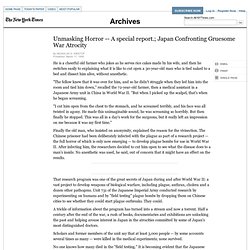
KRISTOFPublished: March 17, 1995 He is a cheerful old farmer who jokes as he serves rice cakes made by his wife, and then he switches easily to explaining what it is like to cut open a 30-year-old man who is tied naked to a bed and dissect him alive, without anesthetic. Wheat in Japan: How the nation learned to love the American grain instead of rice. Photograph by Justin Sullivan/Getty Images.

Unlike other popular Japanese gadgetry, the Gopan bread maker isn’t sleek, nor does it fit in a trouser pocket. But Panasonic's $600 kitchen aid does boast a trump card: It produces freshly baked loaves from raw, whole grains of rice.* Since its launch in November 2010, the appliance—whose name is an inspired play on gohan, meaning “cooked rice,” and pan, meaning “bread”—has been selling like hotcakes in Japan (the only country where it’s currently available).
You might not be surprised that a rice-oriented appliance is popular in Japan—it is, after all, the home of sushi and okayu. But you should be. The engineers behind the Gopan were tasked to come up with a machine to encourage consumers to eat more rice. How did Japan come to be a wheat-obsessed nation that needs gimmicks like the Gopan to eat rice disguised as wheat flour? Eleven months after the tsunami and earthquake ravaged Japan new pictures show the incredible progress being made in the multi-billion pound clear up. By David Baker Updated: 10:35 GMT, 13 February 2012 When Japan was hit by both an earthquake and tsunami in quick succession in March last year, the images of devastation gripped the world.
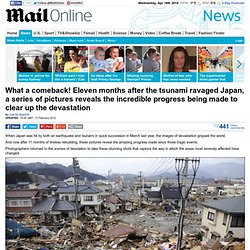
And now after 11 months of tireless rebuilding, these pictures reveal the amazing progress made since those tragic events. Photographers returned to the scenes of desolation to take these stunning shots that capture the way in which the areas most severely affected have changed. Angela Saini - A risk worth taking. Amid the news coverage following the devastating tsunami that hit Fukushima in March last year, there was one headline that struck me as particularly odd.

It was a month later, in April, when world leaders were hastily re-examining the safety levels of their nuclear facilities or, like Germany, shelving their new reactors altogether, that Russian Prime Minister Vladimir Putin announced that his country’s reactors were perfectly safe. In fact, the Voice of Russia radio station reported, “Russia’s nuclear plants 100 per cent safe.” Study that statistic: one hundred per cent safe. You don’t have to be a science journalist to find this a somewhat suspect claim. Are they really saying that under no circumstances could a Russian nuclear reactor ever cause any kind of harm to anyone? Of course, no technology, especially on the scale of a nuclear reactor, is a 100 per cent safe.
Scientists first study of tsunami impact around Fukushima Daiichi shows waves over 21 meters hit coast. Earlier this month, Japanese scientists warned that the Fukushima Daiichi nuclear station was at a greater risk from future earthquakes than previously estimated.

The March 11th earthquake was the most powerful known earthquake ever to have hit Japan, and one of the five most powerful earthquakes in the world since modern record-keeping began in 1900. The huge scale of the Great East Japan Earthquake has resulted in forcing the Japanese government to review the basic principles of its earthquake risk assessment system and may have far-reaching consequences for anti-quake measures in homes, offices and nuclear power plants across the country. A group of Japanese scientists and prefectural officials by University of Tokyo Professor Shinji Sato have found that a tsunami more than 21 meters high hit the coast near the Fukushima Daiichi nuclear plant on March 11th last year.
Chaos among Officials Bedeviled Japan During 2011 Tsunami Disaster. As Japanese officials consider whether and when to reactivate most of the country's 54 nuclear plants, a year after the Fukushima reactor disaster, they continue to face challenges to public confidence in the nuclear industry and its regulator.
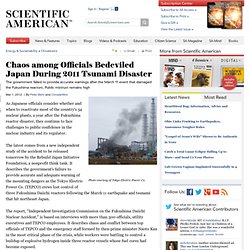
Japan's refusenik farmers tackle nuclear waste - environment - 09 March 2012. Nobuyoshi Ito watched the explosions at the crippled Fukushima nuclear plant from his hilltop farm, which lies just 30 kilometres away in Iitate village.
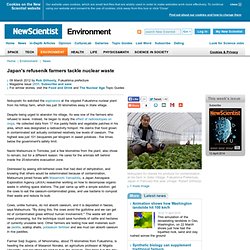
Despite being urged to abandon his village, Ito was one of the farmers who refused to leave. Instead, he began to study the effect of radioisotopes on crops. He collected data from 17 rice paddy fields and vegetable patches in his area, which was designated a radioactivity hotspot. He claims that food grown in contaminated soil actually contained relatively low levels of caesium. The highest was just 101 becquerels per kilogram in sweet potatoes - five times below the government's safety limit. "Japan’s Revenge of the Mandarins" by Masahiro Matsumura. Exit from comment view mode.

Click to hide this space. "Japan’s Resilience Lessons" by Margareta Wahlström. Exit from comment view mode.
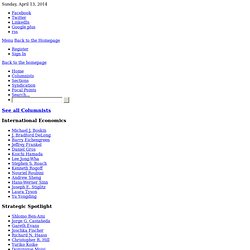
Click to hide this space. Former Japanese PM Naoto Kan on the Fukushima Disaster. Japan's Post-Fukushima Earthquake Health Woes Go Beyond Radiation Effects. After the March 11, 2011, earthquake and tsunami crippled Japan's Fukushima Daiichi nuclear power plant, worry about the unfolding nuclear accident quickly commandeered international headlines.
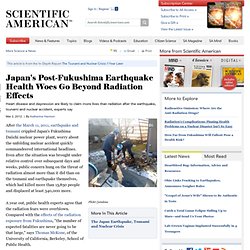
"Japan’s Rubble Economy" by Yuriko Koike. Exit from comment view mode. Click to hide this space TOKYO – On March 11, a year will have passed since Japan was struck by the triple tragedy of an earthquake, tsunami, and nuclear accident. According to figures announced by the country’s National Police Agency, the Great East Japan Earthquake left behind 15,848 dead and 3,305 missing – the largest loss of life due to natural disaster in Japan since World War II. Pet Rescuers Venture Into Japan's Exclusion Zone - In Focus. Nearly a year after the earthquake, tsunami, and nuclear disaster that struck Japan, a 20-km (12-mi) radius exclusion zone remains in place around the crippled Fukushima Daiichi nuclear power plant.
Residents were evacuated quickly, leaving behind many things, including pets and livestock. Members of United Kennel Club Japan recently ventured into the zone to rescue abandoned dogs and cats that have been fending for themselves for months. The Japanese government recently said it would draw up new evacuation zones by the end of April, and that areas where annual radiation levels are currently higher than 50 millisieverts will not be deemed suitable for living for at least five years.
Below are recent images from inside Japan's exclusion zone. The last six images are interactive: starting with number 29 click them to view a fading before/after comparison of Google Streetview images. [34 photos] Use j/k keys or ←/→ to navigate Choose: - javascript required. Made Better in Japan. Imagine going into an espresso bar, as I did in Tokyo, ordering a single shot, and being told that it's not on offer.
The counter at No. 8 Bear Pond may feature the shiniest, spiffiest, newest La Marzocco, as well as a Rube Goldberg–esque water-filtration system, but the menu, which lists lattes and Americanos, makes no mention of espresso or cappuccino. Japan's Enviable Decline - An FP Slideshow. The world has gotten used to gloomy news coming out of Japan. And recently, it hasn't been disappointed: New reports suggest that the Fukushima Daiichi nuclear power plant, which was stricken during last year's tsunami, may be sitting on top of an active geological fault line, further dimming the chances that it will ever resume operations.
Japanese utilities are predicting massive power shortages this summer as the demand for electricity exceeds available supply by as much as 20 percent. Meanwhile, the central bank is meeting to discuss the country's worrisome inflation rates, and Europe's austerity measures have reduced the demand for Japanese exports. Japan Awakens - By Michael Auslin. The meeting of Japanese Prime Minister Yoshihiko Noda with U.S. President Barack Obama and Secretary of State Hillary Clinton in Washington made few headlines this week, but quiet changes underway in Japan's decades-long tradition of pacifism will have profound implications for the balance of power in Asia. Behind Japan's Big Arms Buy.